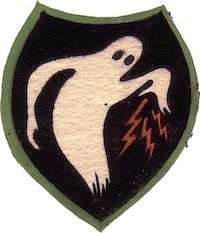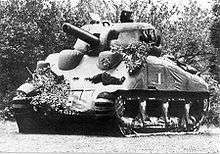Ghost Army

The Ghost Army was a United States Army tactical deception unit during World War II officially known as the 23rd Headquarters Special Troops.[1] The 1,100-man unit was given a unique mission within the U.S Army: to impersonate other U.S. Army units to deceive the enemy. From a few weeks after D-Day, when they landed in France, until the end of the war, they put on a "traveling road show" utilizing inflatable tanks, sound trucks, fake radio transmissions and pretence. They staged more than 20 battlefield deceptions, often operating very close to the front lines. Their story was kept secret for more than 40 years after the war, and elements of it remain classified.[2] The unit was the subject of a PBS documentary The Ghost Army in 2013.[3]
History and deployment
Inspiration for the unit came from the British units who had honed the deception technique for the battle of El Alamein in late 1942, as Operation Bertram. The U.S. unit had its beginnings at Camp Forrest, Tennessee, and was fully formed at Pine Camp, NY (now Fort Drum), before sailing for the United Kingdom in early May 1944. In Britain they were based near Stratford upon Avon, and troops participated in Operation Fortitude, the British-designed and led D-Day deception of a landing force designated for the Pas-de-Calais.
Some troops went to Normandy two weeks after D-Day, where they simulated a fake Mulberry harbour at night with lights which attempted to draw German artillery from the real ones. After which the entire Unit assisted in tying up the German defenders of Brest by simulating a larger force than was actually encircling them.
As the Allied armies moved east, so did the 23rd, and it eventually was based within Luxembourg, from where it engaged in deceptions of crossings of the Ruhr river, positions along the Maginot Line, Hürtgen Forest, and finally a major crossing of the Rhine to draw German troops away from the actual sites.
Recruiting
Ghost soldiers were encouraged to use their brains and talent to mislead, deceive and befuddle the German Army. Many were recruited from art schools, advertising agencies and other venues that encourage creative thinking. In civilian life, ghost soldiers had been artists,[4] architects, actors, set designers and engineers.[2] Although the 23rd Headquarters Special Troops consisted of only 1,100 soldiers, the contingent used equipment pioneered by British forces such as dummy tanks and artillery, fake aircraft and giant speakers broadcasting the sounds of men and artillery to make the Germans think it was upwards of a two-division 30,000 man force. The unit's elaborate ruses helped deflect German units from the locations of larger allied combat units.
The unit consisted of the 406th Combat Engineers (which handled security), the 603rd Camouflage Engineers, the 3132 Signal Service Company Special and the Signal Company Special.
Tactics
Visual deception

The visual deception arm of the Ghost Army was the 603rd Camouflage Engineers. It was equipped with inflatable tanks,[5] cannons, jeeps, trucks, and airplanes that the men would inflate with air compressors, and then camouflage imperfectly so that enemy air reconnaissance could see them. They could create dummy airfields, troop bivouacs (complete with fake laundry hanging out on clotheslines), motor pools, artillery batteries, and tank formations in a few hours. Many of the men in this unit were artists, recruited from New York and Philadelphia art schools. Their unit became an incubator for young artists who sketched and painted their way through Europe. Several of these soldier-artists went on to have a major impact on art in the post-war US. Bill Blass,[6] Ellsworth Kelly, wildlife artist Arthur Singer, and Art Kane were among the many artists who served in the 603rd.
Sonic deception
The 3132 Signal Service Company Special handled sonic deception. The unit coalesced under the direction of Colonel Hilton Railey, a colorful figure who, before the war, had “discovered” Amelia Earhart and sent her on her road to fame.
Aided by engineers from Bell Labs, a team from the 3132 went to Fort Knox to record sounds of armored and infantry units onto a series of sound effects records that they brought to Europe. For each deception, sounds could be “mixed” to match the scenario they wanted the enemy to believe. This program was recorded on state-of-the-art wire recorders (the predecessor to the tape recorder), and then played back with powerful amplifiers and speakers mounted on halftracks. The sounds they played could be heard 15 miles (24 km) away.[2]
Radio deception
"Spoof radio", as it was called, was handled by the Signal Company. Special Operators created phony traffic nets, impersonating the radio operators from real units. They were educated in the art of mimicking a departing operator’s method of sending Morse Code so that the enemy would never detect that the real unit and its radio operator were long gone.
Atmosphere
To complement existing techniques, the unit often employed theatrical effects to supplement the other deceptions. Collectively called "atmosphere",[7] these included simulating actual units deployed elsewhere by the application of their divisional insignia, painting appropriate unit insignia on vehicles and having the individual companies deployed as if they were regimental headquarters units. Trucks/Lorries would be driven in looping convoys with just two troops in the seats near the rear, to simulate a truck full of infantry under the canvas cover. "MP's" (Military Police) would be deployed at cross roads wearing appropriate divisional insignia and some officers would simulate divisional generals and staff officers visiting towns where enemy agents were likely to see them. A few actual tanks and artillery pieces were occasionally assigned to the unit to make the "dummies" in the distance appear more realistic.
See also
- The Ghost Army (2013, Documentary)
References
- ↑ "23rd Hqs, Special Troops". nasaa-home.org. Archived from the original on 2016-01-05. Retrieved 2016-01-21.
- 1 2 3 Garber, Megan (May 22, 2013). "Ghost Army: The Inflatable Tanks That Fooled Hitler". The Atlantic. Retrieved May 23, 2013.
- ↑ Binkovitz, Leah (May 21, 2013). "When an Army of Artists Fooled Hitler". Smithsonian.com. Retrieved May 23, 2013.
- ↑ Binkovitz, Leah. "When an Army of Artists Fooled Hitler". Smithsonian. Retrieved 2016-01-21.
- ↑ "The 23rd Headquarters Special Troops: The Phantom Menace". Mental Floss. Retrieved 2016-01-21.
- ↑ "Exhibit and film celebrate World War II's Ghost Army". The Boston Globe. 2012-02-23. Retrieved 2012-09-06.
- ↑ "The Artist-Filled Shadow Army of World War II". Hyperallergic. Retrieved 2016-01-21.
Further reading
- Beyer, Rick; Sayles, Elizabeth (April 28, 2015). The Ghost Army of World War II: How One Top-Secret Unit Deceived the Enemy with Inflatable Tanks, Sound Effects, and Other Audacious Fakery. Princeton Architectural Press. ISBN 978-1616893187.
- Gawne, Jonathan (2002). Ghosts of the ETO : American tactical deception units in the European theatre, 1944-1945. Havertown, PA: Casemate. ISBN 978-0971170957.
- Gerard, Philip (2002). Secret soldiers : the story of World War II's heroic army of deception (1 ed.). New York: Dutton. ISBN 978-0525946649.
- Kneece, Jack (2001). Ghost army of World War II. Gretna: Pelican Publishing. ISBN 978-1565548763.
External links
- Official website of The Ghost Army documentary
- Holley, Joe. (2006, July 8). Louis Dalton Porter; Used Artistic Skills to Trick German Army. The Washington Post, p. B6
- NPR: Artists of Battlefield Deception: Soldiers of the 23rd
- National Army Security Agency Association